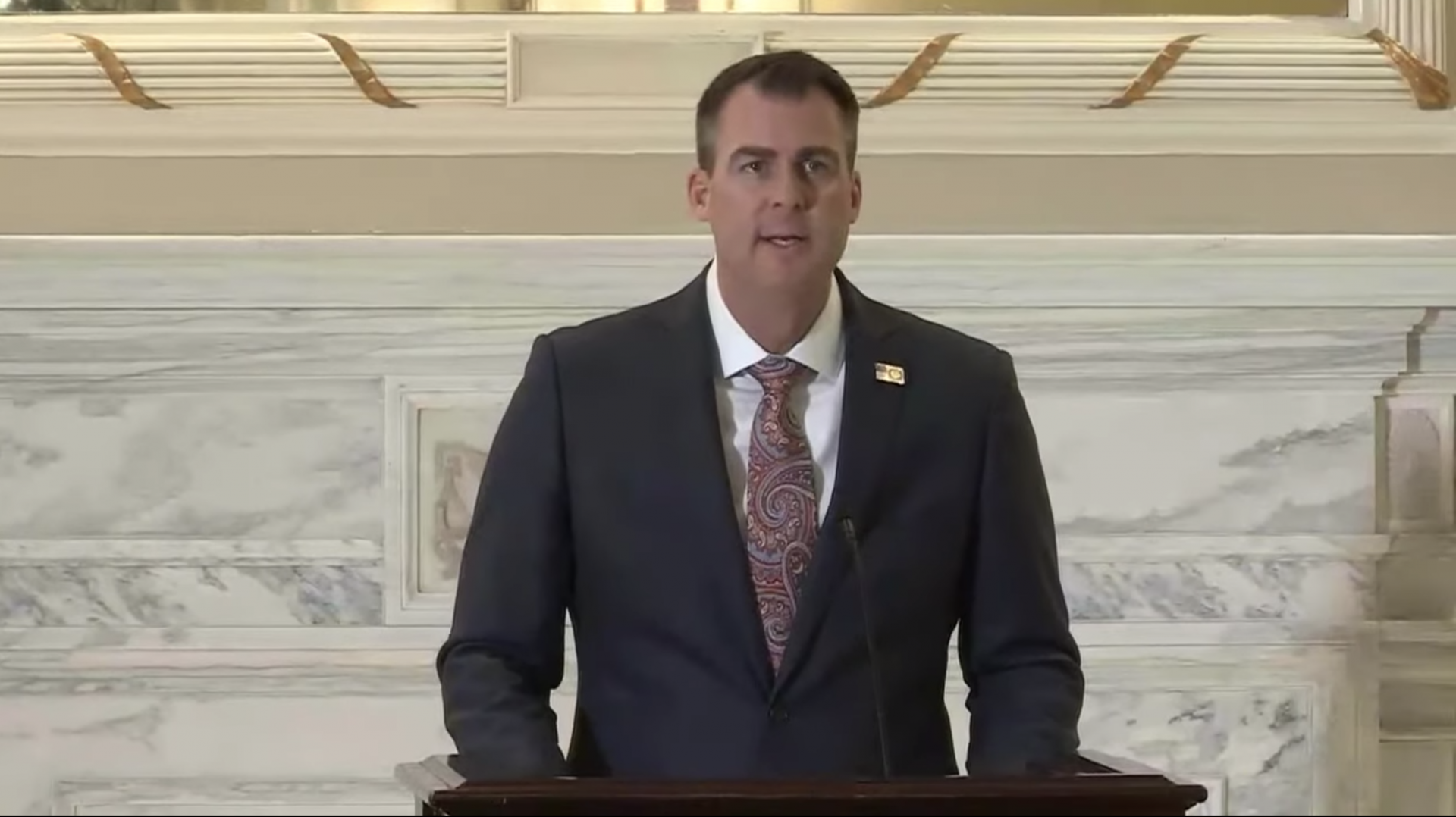
Gov. Kevin Stitt, during his public address on the state employee substitute teacher program on Jan. 18, 2022 in the Blue Room of the State Capitol.


Gov. Kevin Stitt, during his public address on the state employee substitute teacher program on Jan. 18, 2022 in the Blue Room of the State Capitol.
Gov. Kevin Stitt held one of his first COVID-19 briefings in several months on Tuesday, as health and education leaders expressed fears that the severe Omicron surge was getting worse. His address, which introduced a controversial policy to combat the state’s acute substitute teacher shortage, contradicted much of what the experts had said hours before he took to the podium.
In the press conference, Stitt was resolute about keeping students in schools as the coronavirus surges across the state.
“Oklahoma students deserve that option of being in person, in class with their teachers,” he said.
An executive order from Stitt is paving the way for Oklahoma’s more than 30,000 state employees to work as substitute teachers as omicron ravages schools.
With more than half of Oklahoma’s schools having to close or pivot to distance learning due to staffing shortages created by the coronavirus so far this semester, Stitt said his executive order will allow state employees to step in.
“I’m asking all state employees to see what they can do, because in person learning is so, so important for the future of that specific child, but also for the state of Oklahoma,” he said.
State officials said state employees will still be paid as part of their day jobs, while subbing in local districts, saving money because districts won’t have to pay substitute teachers.
Substitute pay can vary, but the most qualified make $120 a day at Oklahoma City Public Schools.
It will be up to employees to sign up to be substitutes and they will have to pass a background check and complete district-specific training to be allowed into classrooms. It’s unclear how long that process could take, but Stitt administration officials said they hope state employees will start reaching out to school districts as soon as possible.
State Superintendent of Public Instruction Joy Hofmeister issued a release agreeing that schools should stay open, but she criticized the plan.
“This gesture is a cup of water on a raging fire,” the statement reads in part. “The immediate problem is that we are in the middle of a tremendous surge, impacting more than schools. Oklahomans are seeing the ramifications of COVID in their workplaces, churches and families.
With the stroke of a pen, the governor could untie the hands of schools to mitigate spread and allow hospitals to increase capacity. The governor could immediately deploy the national guard to assist with school transportation and food services using millions of COVID relief dollars already in hand.”
That tremendous surge is what led hospital leaders from Oklahoma City’s largest health systems to hold a briefing, describing crisis-level strain.
As in earlier stages of the pandemic, the four health systems — INTEGRIS, Mercy, OU Health and SSM Saint Anthony — began issuing their own bed and ICU capacity data. For several days, none of the systems have had one ICU bed open. Executives from the systems took to the airwaves Tuesday to explain how dire the state’s hospitalization situation is. Again, they spoke of short staffing in both medical and non-medical positions, full ICUs, full ERs, patients being transferred out of state, and patients — who couldn’t get a transfer secured — dying. The overall number of hospitalizations — now over 1,400 — is creeping toward last year’s record, and hospitals have even more staff shortages than they did then.
“Make no mistake, while you may feel that Omicron variants are mild and dismissible, now is the time to realize that you couldn’t be further from the truth,” said Dr. Kersey Winfree, of SSM Saint Anthony. “We are here today to sounding the alarm. It is spreading rapidly, making many people with chronic illnesses sicker and disrupting our communities — as well as our health care workforce, with infections among our employees and their families.”
Other medical professionals, who are members of the Healthier Oklahoma Coalition, held their regular briefing to discuss ongoing case and hospitalization growth. Health experts warned that hospitals are getting hit harder now than ever, and that they doubt it will let up soon.
Oklahoma Hospital Association President Patti Davis noted that hospitalization trends lag behind case trends, and the 7-day average hasn’t begun to dip significantly.
“It’s very important for the public to understand we have not hit our peak yet,” she said.
Health professionals in each briefing discussed policies that could help mitigate spread, including mask requirements and encouraging work-from-home practices when available. One of the most helpful tools, Winfree said during the hospital executive briefing, would be getting health experts and state officials on the same page.
“People are very anxious,” he said. “A lot of the anxiety about potential danger to themselves, their loved one’s, coworkers can be, I think, addressed and reassured whenever we’re aligned in our messaging. The actual messages that we currently are trying to share could be made louder with the right amount of alignment from state leadership.”
During his address, Stitt emphasized that hospitalization numbers are not as high now as they were in the January 2021 spike. He noted that surrounding states have seen their cases go down.
“The good news, that they just shared with me from the Department of Health, was there are four or five states around us that are starting to see their numbers come back down,” he said, offering examples in Maine, Florida and Louisiana. “So we think we’re about peaked and coming back down on the other side of it.”